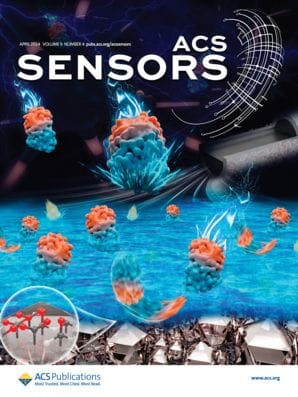A simple fingertip touch to a temporary tattoo sticker could help identify GHB-spiked drinks instantly, thanks to recent developments in wearable chemical sensing.

Gamma-hydroxybutyrate (GHB) is a short-chain fatty acid first developed as an anesthetic in the 1960s, later marketed as a dietary supplement.1 Today, it’s better known for its role in drink spiking incidents at bars and clubs. Victims usually can’t detect GHB by taste, and its effects, ranging from lowered inhibitions to unconsciousness, can begin within 30 minutes and last for hours.
Accurate statistics are hard to come by, but surveys suggest the problem is widespread. In a study of over 6,000 U.S. college students, nearly 8% reported being drugged, and 17% of those experienced unwanted or nonconsensual sexual contact.2 GHB’s ease of synthesis from common precursors means it remains a persistent threat, making detection tools a critical part of prevention efforts.
The challenge of real-time detection
Traditional detection methods, including fluorescent and colorimetric sensors, often require specialized equipment that limits their usefulness for on-the-spot testing in social settings. Researchers in South Korea previously reported in ACS Nano on a skin-attached colorimetric sensor they developed using hydrogel and nanofiber, aiming for a simple, confidential self-protection platform. While promising, their earlier versions struggled with durability and sensitivity.3,4
A new approach: the tattoo sensor
In the team's latest work, published in ACS Sensors, they introduce a temporary tattoo designed for rapid, non-invasive GHB detection. The tattoo sticker incorporates a colorimetric sensor that responds to GHB by changing color, enabling real-time monitoring without extra devices.5
How it works: The tattoo consists of a polydimethylsiloxane (PDMS) film, PVA solution, and agarose gel embedded with the BHEI chemical receptor. When a user dips a finger in a drink and touches the tattoo, the sensor reacts with GHB, turning bright red at concentrations as low as 0.01 mg/mL. The response is nearly instantaneous—within one second—and works in a range of beverages, both alcoholic and non-alcoholic. The color change also remains visible for up to 30 days, which could be useful for evidence collection.
Other approaches and the future of wearable sensing
Other potential options have included dual-probe systems and portable sensing chips resembling makeup compacts, which use colorimetric-fluorescent methods for reliable GHB detection. There’s also a DIY electrochemical finger device, printable with a standard 3D printer, that connects to a smartphone for quick, multi-analyte testing. These innovations help expand the toolkit for both personal safety and forensic investigations.6
Wearable chemical sensors are evolving rapidly, and the temporary tattoo is a promising step forward. The authors hope these devices will soon be available to the public, offering a practical, cost-effective layer of protection in social environments.
Browse related research on wearable sensors in ACS journals:
Wearable Double Network Plasmonic Hydrogel for SERS Detection of Urea and Uric Acid in Sweat
Jing Zhu, Wenrou Yu, Hongyuan Xiong, Xuliang Xia*, Yunlong Li, and Yingzhou Huang*
DOI: 10.1021/acssensors.5c01745
Advancing Wearable VOC Sensors: A Roadmap for Sustainable Agriculture and Real-Time Plant Health Monitoring
Sina Jamalzadegan, Jin Xu, Yiyang Shen, Belinda Mativenga, Mingzhuo Li, Mohammadreza Zare, Akhil Penumudy, Zach Hetzler, Yong Zhu, and Qingshan Wei*
DOI: 10.1021/cbe.5c00027
Synergizing Nanosensor-Enhanced Wearable Devices with Machine Learning for Precision Health Management Benefiting Older Adult Populations
Zhihao Li, Bangshun He, Yiwei Li, Bi-Feng Liu, Guojun Zhang, Songlin Liu*, Tony Ye Hu*, and Ying Li*
DOI: 10.1021/acsnano.5c04337
3D-Printed Flexible Conductive Hydrogel as a Wearable Platform for Dual Functions of Strain and Colorimetric Lactate Sensors
Natchapat Kearwan, Nadtinan Promphet, Nadnudda Rodthongkum, Voravee P. Hoven, and Benjaporn Narupai*
DOI: 10.1021/acsami.5c10251
Smart Wearable Sensor Fuels Noninvasive Body Fluid Analysis
Kang Wang, Wenjing Liu, Jingzhi Wu, Heng Li, Hai Peng, Junhui Zhang, Ke Ding, Xiaoxing Wang, Chengyi Hou*, Hong Zhang*, and Yang Luo*
DOI: 10.1021/acsami.4c22054
Emerging Technologies in Wearable Sweat Sensors for Next-Generation Real-Time Health Monitoring
Thiago F. Santos*, Felipe Mendonca Fontes Galvão, Leônidas Oliveira Neto, and Jose H. O. Nascimento*
DOI: 10.1021/acsmaterialslett.5c00706
References:
- Trombley, T. A. et al. DARK Classics in Chemical Neuroscience: Gamma-Hydroxybutyrate (GHB). ACS Chem. Neurosci. 2020, 11, 23, 3850–3859.
- Swan, S. C. et al. Just a dare or unaware? Outcomes and motives of drugging (“drink spiking”) among students at three college campuses. Psychology of Violence, 7(2), 253–264.
- Kim, G.- J. et al. Second Skin as Self-Protection Against γ-Hydroxybutyrate. ACS Nano 2023, 17 (24), 25405–25418.
- Ha, S. et al. In situ, real-time, colorimetric detection of γ-hydroxybutyric acid (GHB) using self-protection products coated with chemical receptor-embedded hydrogel. Biosens. Bioelectron. 2022, 207, 114195.
- Kim, G.- J. et al. Tattoo Sticker for GHB Detection to Prevent Date Rape. ACS Sens. 2025. DOI: 10.1021/acssensors.4c03737.
- Zhang, S. et al. Electronic Effect Driven Specific and Sensitive Recognition toward GHB. Anal. Chem. 2024, 96, 22, 9026–9033.
